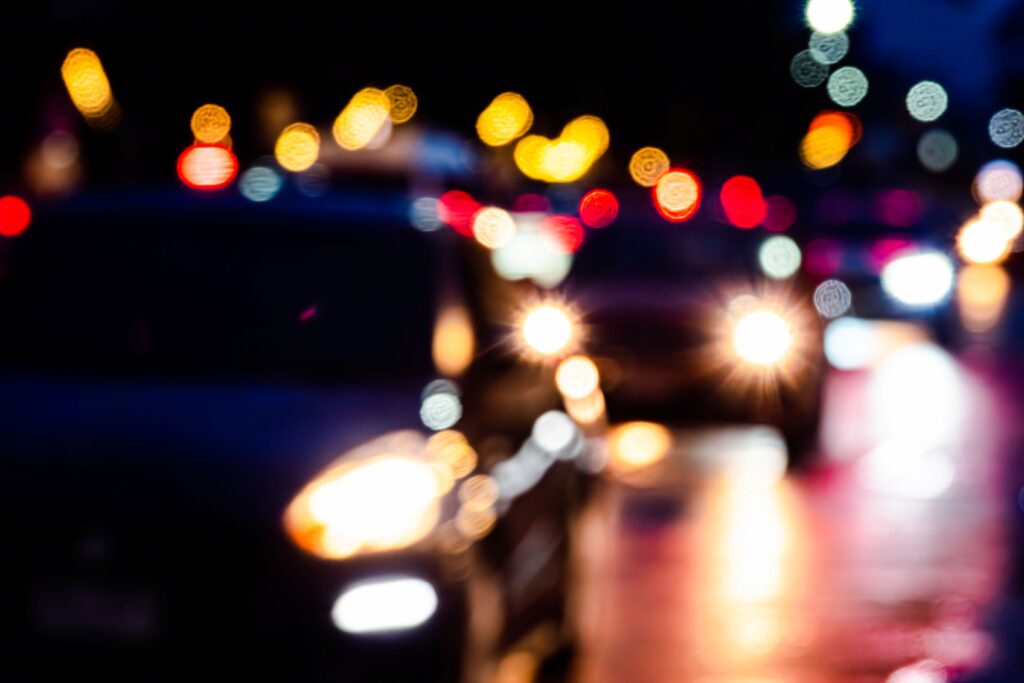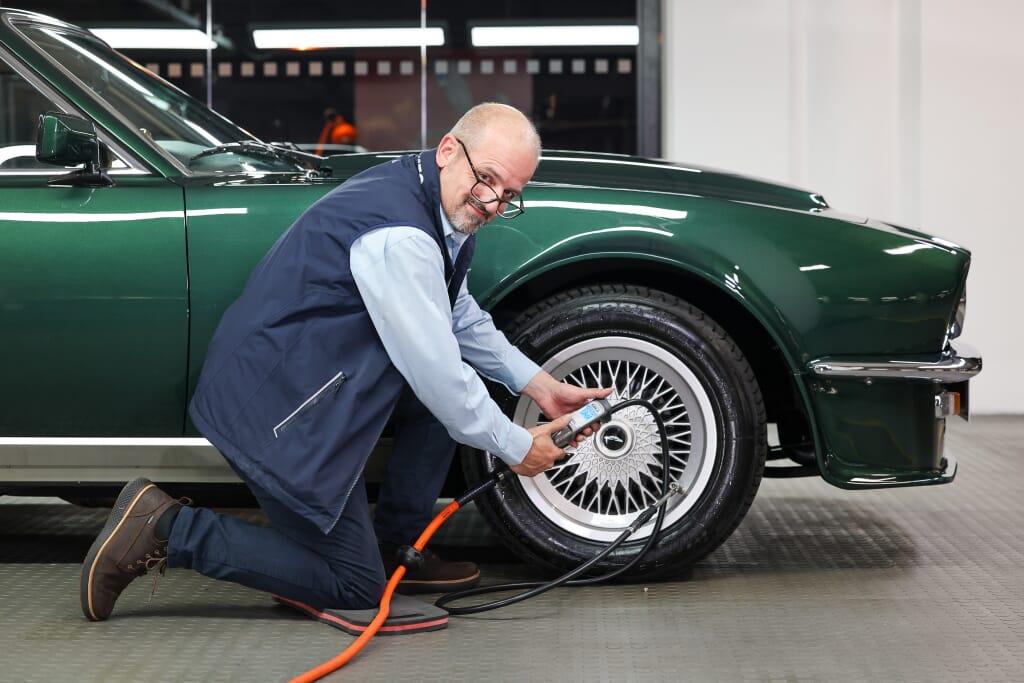
Driving safely at night comes down to having the right preparation and adopting the right driving habits. As we turn the clocks back this month and lose light earlier, here are our top tips on how to drive at night safely – with practical advice for all motorists, from modern GT owners to those taking their classic out for a twilight run.
Driving tips for night time

When the sun sets, visibility, reaction time and concentration all come under greater strain. Even well-lit A-roads hide hazards: unlit junctions, wildlife, and dazzle from oncoming traffic. Despite lower traffic volumes, the potential for incidents to occur when driving at night is high.
Safe driving in the dark can be a challenge if you’re not used to it – 31% of drivers are afraid of driving at night according to lens manufacturer, Essilor. But, if you follow our tips and make a few small tweaks to your night-driving habits, you’ll not think twice about the clocks going back. Here’s what the experts recommend:
1. Get your eyes tested
You may have been awarded 20/20 vision back when you were at school, but if you struggle with glare or halos around lights, it could be a sign that you need your eyesight checked. Even minor prescription changes can make a major difference at night. Equally, you may have an undiagnosed astigmatism which can make judging distances and driving at night a whole other level of tricky.
2. Reduce headlight glare
Headlight glare is a growing problem in the UK. Dazzling headlights cause what is known as ‘discomfort glare’, but research suggests that it causes more than mere ‘discomfort’. In a recent survey by the RAC, over half of respondents said they are temporarily blinded, while four-in-10 say they feel less safe driving as a result of bright headlights on other vehicles. Others report tiredness, headaches and even migraines, thought to be caused by headlight glare.
The increase in headlight glare can be attributed to a number of factors – new LED technology, improper headlight alignment and increased vehicle heights are all thought to contribute.
Driving tips for night time to manage headlight glare:
- When faced with lights from oncoming traffic, keep your eyes open and cast your eyes to look at the curb or side of the road.
- Adjust your rear view mirror at night to reduce the effect of bright headlights behind you. Newer cars have self-dimming mirrors that can also help, although you may notice you still experience unavoidable glare through your wing mirrors.
- If you are dazzled while driving it’s important to safely slow down, or even stop your vehicle until your vision improves.
- Be thoughtful to other road users and dip your headlights early when required. If you have automatically dimming headlamps, they don’t always pick up oncoming cars, cyclists and pedestrians, so dip them manually.
- To help prevent headlight glare for other drivers, ensure your headlights are clean, and properly aligned.
3. Adapt your speed and spacing
At night, hazards appear later and your stopping distance must compensate. That means reducing speed and no tail-gating – leave a bigger gap between you and the vehicle in front.
Always drive within your headlight range – meaning you should be able to stop within the distance illuminated by your lights. Maintaining a wider gap to the vehicle ahead improves reaction time and also reduces glare from its rear lights.
4. Stay alert and manage fatigue
Staying alert while driving is perhaps the greatest challenge of night-time motoring. Fatigue sets in more quickly after dark, especially in the early morning hours. When you can’t stop yawning, or you feel like you need matchsticks to prop your eyelids open, you know it’s a sign to pull over.
A brief roadside nap, caffeine, or a walk in fresh air can restore focus – but that’s only a short term fix. If you’re genuinely tired, and you still have some distance to travel, there’s no substitute for proper rest.
How to stay alert while driving:
- Recognise early signs of tiredness and take action promptly
- Keep the cabin cool – opening a window for fresh air can help
- Take regular breaks every two hours
- Share driving duties on long trips
5. Reduce interior reflection
Interior lights, bright screens and reflective surfaces all diminish visibility. Dim dashboard lighting to the lowest comfortable level and avoid unnecessary illumination – that means no back seat drivers playing on their phones!
Keep surfaces clean and smudge-free. A soft microfibre cloth can remove film from the inside of the windscreen, which often causes glare when headlights strike it. If you wear glasses, give them a wipe before driving. It’s also a good idea to carry a spare pair of anti-glare glasses, even if you don’t normally need corrective lenses – they can make a significant difference on night journeys.
6. Keep your car well maintained
Making sure your car is in tip-top condition is always important, but at night-time it’s essential. As the evenings draw in, autumn night driving brings added considerations: wet leaves, fog, and sudden temperature drops. Tyres with good tread depth are essential, as are clean wiper blades and topped-up washer fluid. Make sure your brake pads are in good order, so you can manage those stopping distances, and pay special attention to headlight safety. You should also carry an emergency kit and reflective jacket in the boot in case you need to stop.
As mentioned above, to help prevent headlight glare for other drivers, ensure your headlights are clean, and properly aligned. Washing them regularly can stop the build-up of dirt and grime, which otherwise can cause the lights to dazzle drivers. When it comes to headlight alignment, this can be affected by load – if you are carrying passengers and luggage, the lights will naturally sit higher than usual. Some newer cars will adjust headlight alignment automatically but refer to the car’s handbook for guidance.
Autumn night driving checklist
Here’s our eight-point check-list for driving safely at night:
- Get your eyes tested
- Check tyre pressure and treads
- Top up washer fluid and replace wiper blades
- Reduce speed and no tail-gating
- Take steps to limit internal and external glare
- Carry an emergency kit and reflective jacket in the boot
- Keep a phone charger (that works!) in the car
- Don’t drive if you feel tired
Are you prepared for night driving this winter?
At Windrush Car Storage, we will make sure your car is primed, ready and waiting for its next venture, even if that is in the middle of the night and the depths of winter. However, for performance and classic car owners who prefer not to drive during the darker months, secure car storage offers an ideal alternative.
Contact us to talk about safe, secure storage options for the winter in London and the Cotswolds.
Frequently Asked Questions (FAQ)

How can I drive at night safely?
To drive safely at night, ensure your headlights are clean and correctly aligned, reduce speed, and stay alert to fatigue. Keep your windscreen clear and maintain safe following distances to allow more reaction time.
What are the best night driving safety tips?
The best driving tips for night time include adjusting your driving style, dimming your dashboard lights, and avoiding looking directly at oncoming headlights. Plan rest stops and take breaks to maintain concentration.
How can I stay alert while driving at night?
Rest before long journeys, take a 15-minute break every two hours, and avoid heavy meals or alcohol. Listening to calm music and keeping the air temperature cool can also help you stay awake.
Why is night driving more dangerous?
Darkness limits depth perception and reaction time, while glare from headlights can obscure hazards. Fatigue and reduced visibility make collisions more likely, especially on rural or unlit roads.




